Motorace USA / Traverse USA / Zippy Race
 The Game: As the lone motorcyclist in a cross-country car race, you have to dodge your opponents at high speed, one two-ton vehicle at a time. You drive through city streets, highways, and through the rough desert, trying to reach your goal without running out of gas or getting splattered across the asphalt. (Williams Electronics [under license from IREM], 1983)
The Game: As the lone motorcyclist in a cross-country car race, you have to dodge your opponents at high speed, one two-ton vehicle at a time. You drive through city streets, highways, and through the rough desert, trying to reach your goal without running out of gas or getting splattered across the asphalt. (Williams Electronics [under license from IREM], 1983)
Memories: Whatever you called it, this was one of my favorite driving/racing games, combining the best elements of both maze games and scrolling obstacle course games, and handling things differently from the Pole Position and Turbo formula which dominated this particular genre at the time.
Major Havoc
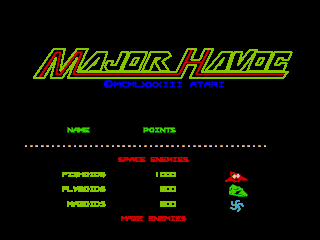
 The Game: Journey through space, visit free-floating outposts, and raid ’em in search of oxygen. Then you just have to get back out with your precious loot – and that’s the hard part. (Atari, 1983)
The Game: Journey through space, visit free-floating outposts, and raid ’em in search of oxygen. Then you just have to get back out with your precious loot – and that’s the hard part. (Atari, 1983)
Memories: Introduced to much fanfare in 1983, Atari’s Major Havoc may well have been the last of the red-hot vector graphics games – and truth be told, it didn’t catch on like the wildfire their marketing materials seemed to be hinting at. It was a really challenging game too – it was easy to lose a lot of quarters to this machine.
Marble Madness
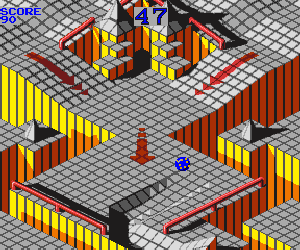
 The Game: You control the speed and direction of a marble which is racing other marbles to reach the finish line. Obstacles along the way include marble-eating creatures, treacherous cliffs and drawbridges, and the game’s own trakball controller! (Atari, 1983)
The Game: You control the speed and direction of a marble which is racing other marbles to reach the finish line. Obstacles along the way include marble-eating creatures, treacherous cliffs and drawbridges, and the game’s own trakball controller! (Atari, 1983)
Memories: One of the most bizarrely abstract games to emerge from the post-Pac-Man ’80s, Marble Madness is like a virtual homage to those wooden maze-under-glass games, in which you’d try to shift the game to various angles and get a ball bearing to go where you wanted it to go. Marble Madness does away with the moving-the-whole-maze element and puts the marble under its own power – and that’s just where the frustration begins!
Mappy
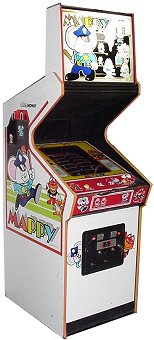
 The Game: Mappy the Mouse stars in “Micro Police!” You are Mappy, a mouse determined to bring Boss the Big Bit and his kooky kitty kohorts to justice before they make a huge hail on a house heist. You can snatch up the potential booty yourself to keep it safe, and can temporarily foil your feline foes by slamming doors on them, or by opening special glowing doors which blast them away with a burst of sound. If you snatch up all the treasures and avoid the cats, it’s off to the next level. Periodically, you get to pop balloons on a bonus level for extra points. (Bally/Midway [under license from Namco], 1983)
The Game: Mappy the Mouse stars in “Micro Police!” You are Mappy, a mouse determined to bring Boss the Big Bit and his kooky kitty kohorts to justice before they make a huge hail on a house heist. You can snatch up the potential booty yourself to keep it safe, and can temporarily foil your feline foes by slamming doors on them, or by opening special glowing doors which blast them away with a burst of sound. If you snatch up all the treasures and avoid the cats, it’s off to the next level. Periodically, you get to pop balloons on a bonus level for extra points. (Bally/Midway [under license from Namco], 1983)
Memories: You know, it’s just possible that Namco and Bally/Midway put the tail before the dog (or, in this case, the mouse) this time around. With the arcade cabinet’s positively mammoth marquee, and the hint that Mappy was the star of this game and would presumably star in future games, one wonders if the American distributors of Pac-Man were perhaps just a little too certain that everything coming out of their plants would be the dawn of a new franchise.
Mario Bros.
 The Game: Twin brothers Mario and Luigi give up the illustrious life of ape-chasers and damsel-rescuers for their original line of work… plumbing. But this doesn’t mean the job’s any less dangerous. Killer lobsters and turtles abound in the sewer system (well, isn’t it that way everywhere?), along with airborne fireballs not unlike the foxfires in the original Donkey Kong. Another key event in this game? Nintendo solidifies its near-total dominance of the video game industry for the better part of the following decade and a half. (Nintendo, 1983)
The Game: Twin brothers Mario and Luigi give up the illustrious life of ape-chasers and damsel-rescuers for their original line of work… plumbing. But this doesn’t mean the job’s any less dangerous. Killer lobsters and turtles abound in the sewer system (well, isn’t it that way everywhere?), along with airborne fireballs not unlike the foxfires in the original Donkey Kong. Another key event in this game? Nintendo solidifies its near-total dominance of the video game industry for the better part of the following decade and a half. (Nintendo, 1983)
Memories: The fourth game in an ongoing line of coin-ops starring either Mario or some member of Donkey Kong’s family, Mario Bros. cemented the rotund plumber as the star of the show, rather than a simian’s sidekick.
Marvin’s Maze
 The Game: Marvin built a maze on two levels, with habitrail-style tunnels to take him from the first floor to the second and back again, and all was well until the Robonoids moved in and took over. Now they’re out to evict Marvin from his own turf! It’s up to you to guide Marvin through his maze, using cunning one-way bridges to escape from the Robonoids and find the power-ups he needs to zap them. Marvin moves on to the next maze (and the next level of difficulty) only by clearing this maze of power-ups and dots. (SNK, 1983)
The Game: Marvin built a maze on two levels, with habitrail-style tunnels to take him from the first floor to the second and back again, and all was well until the Robonoids moved in and took over. Now they’re out to evict Marvin from his own turf! It’s up to you to guide Marvin through his maze, using cunning one-way bridges to escape from the Robonoids and find the power-ups he needs to zap them. Marvin moves on to the next maze (and the next level of difficulty) only by clearing this maze of power-ups and dots. (SNK, 1983)
Memories: I hadn’t heard of this one before, and now I wonder why. In a way, there’s more than a passing resemblance to Crystal Castles, but there’s also a little bit of an homage to Pac-Man‘s power pellets and a little bit of shooting too. So now it’s like Crystal Butt-Kickin’ Castles. With cute character designs that are worthy of Q*Bert.
Libble Rabble
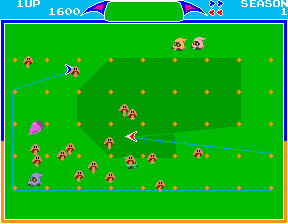 The Game: In a peaceful garden dotted with a gridwork of posts, the player must simultaneously move two pointers, connected to each other by a tenuous string, to trap mobile mushrooms and pointy-hatted garden gnomes. If either pointer comes into contact with a gnome, a life is lost (and, for the record, it’s not the gnome’s life). A scissor-like critter occasionally crosses the screen, and he’s capable of severing the string; a new one instantly forms between the two pointers, but any progress that was made in creating a trap with the string is lost. When all of the creatures invading the player’s garden are trapped, the game begins again at a higher difficulty level; if all of the player’s lives are lost, or time runs out, the game is over. (Namco, 1983)
The Game: In a peaceful garden dotted with a gridwork of posts, the player must simultaneously move two pointers, connected to each other by a tenuous string, to trap mobile mushrooms and pointy-hatted garden gnomes. If either pointer comes into contact with a gnome, a life is lost (and, for the record, it’s not the gnome’s life). A scissor-like critter occasionally crosses the screen, and he’s capable of severing the string; a new one instantly forms between the two pointers, but any progress that was made in creating a trap with the string is lost. When all of the creatures invading the player’s garden are trapped, the game begins again at a higher difficulty level; if all of the player’s lives are lost, or time runs out, the game is over. (Namco, 1983)
Memories: This interesting obscurity from Namco wouldn’t appear to have much historical significance, and it made little or no headway beyond Japan’s borders. What makes Libble Rabble at least a little bit significant is that it was the last arcade game design hurrah of Toru Iwitani, the creator of Namco’s global megahit Pac-Man.
Krull
 The Game: In the video-game adaptation of the movie – which, at the time, was expected to be the next Star Wars-type franchise – you are Colwyn, the hero of the piece. Your first job is to climb a treacherous mountain, dodging boulders, and finding the five pieces of the throwing-star-like Glaive weapon. On the second level, you get to use it against a bunch of nasty swamp creatures who are trying to kill your army. You get to do this for two levels. Then you have to break your men out of a stronghold, and then lead the fight against the invincible chief monster, all to save the princess. (Gottlieb, 1983)
The Game: In the video-game adaptation of the movie – which, at the time, was expected to be the next Star Wars-type franchise – you are Colwyn, the hero of the piece. Your first job is to climb a treacherous mountain, dodging boulders, and finding the five pieces of the throwing-star-like Glaive weapon. On the second level, you get to use it against a bunch of nasty swamp creatures who are trying to kill your army. You get to do this for two levels. Then you have to break your men out of a stronghold, and then lead the fight against the invincible chief monster, all to save the princess. (Gottlieb, 1983)
Memories: Krull wasn’t a bad little game. It might take you a few quarters to get through, and that last level with the main monster was a killer. In a way, Krull is sort of like the opposite of Tron – whereas Tron is best remembered as a game and not a movie, Krull is virtually forgotten as a video game, and the movie still enjoys a small cult following.
Jr. Pac-Man
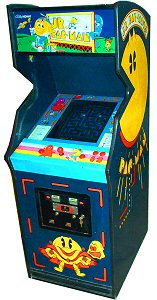 The Game: As the offspring of a round yellow creature consisting of a mouth and nothing else, you maneuver around a bigger maze than your parents ever had to deal with, gobbling small dots and evading four colorful monsters who can eat you on contact. Six large flashing dots in the maze enable you to turn the tables and eat the monsters for a brief period. Periodically, assorted toys will begin hopping through the maze, turning every uneaten dot they touch into a larger dot which yields more points, but also forces little Pac to slow down to digest them. The monsters, once eaten, return to their home base in ghost form and return to chase you anew. If cleared of dots, the maze refills and the game starts again, but just a little bit faster… (Namco, 1983)
The Game: As the offspring of a round yellow creature consisting of a mouth and nothing else, you maneuver around a bigger maze than your parents ever had to deal with, gobbling small dots and evading four colorful monsters who can eat you on contact. Six large flashing dots in the maze enable you to turn the tables and eat the monsters for a brief period. Periodically, assorted toys will begin hopping through the maze, turning every uneaten dot they touch into a larger dot which yields more points, but also forces little Pac to slow down to digest them. The monsters, once eaten, return to their home base in ghost form and return to chase you anew. If cleared of dots, the maze refills and the game starts again, but just a little bit faster… (Namco, 1983)
Memories: In yet another sequel to the most profitable and popular arcade game of all time, the backwards-titled Jr. Pac-Man did away with the life-saving warp tunnels of Pac-Man and Ms. Pac-Man, instead confining the little Pac and his opponents to a larger, horizontally-scrolling maze. The only other innovation was the digestion dilemma caused by the bouncing toys – equivalent to the earlier Pac games’ fruit – turning uneaten dots into larger dots which slow you down enough for the monsters to catch up.
Journey
 The Game: Just another day in the life of the rock group Journey, as you help Steve Perry, Neal Schon, Ross Valory, Jonathan Cain and Steve Smith evade alien “groupoids” intent on keeping them from reaching their next gig. (Bally/Midway, 1983)
The Game: Just another day in the life of the rock group Journey, as you help Steve Perry, Neal Schon, Ross Valory, Jonathan Cain and Steve Smith evade alien “groupoids” intent on keeping them from reaching their next gig. (Bally/Midway, 1983)
Memories: Not one of the brightest ideas ever to occur in the history of arcade games, Journey is an stepchild of the much better Tron video game. Someone, somewhere, thought it was be a brilliant idea to recycle the basics of Tron‘s game play, while attaching a new celebrity licensing opportunity to it. Fresh from two hit rock albums (Escape and Frontiers), Journey seemed a likely choice.
I, Robot
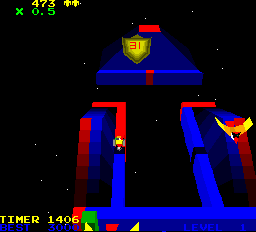 The Game: A huge, Big Brother-like head pops up and says “The law: no jumping!” to your little robot, and naturally, the cocky little automaton has other ideas (replying “Oh yeah!”). And so your mission begins, guiding the robot over ramps, around narrow catwalks, and leaping across huge chasms. If the all-seeing eye opens while your robot it jumping, however, a blaster turns your hero into a heap of spare parts. If you successfully claim all of the red area on the screen, you have a narrow “launch window” in which to jump across to the eye’s platform and destroy it. The your robot launches into space, blowing away obstacles in his path, avoiding saucers and solid objects, and eventually landing on another series of ramps and catwalks to begin the quest anew. And if that doesn’t do it for you, you can put in another quarter and relax in Doodle City. (Atari, 1983)
The Game: A huge, Big Brother-like head pops up and says “The law: no jumping!” to your little robot, and naturally, the cocky little automaton has other ideas (replying “Oh yeah!”). And so your mission begins, guiding the robot over ramps, around narrow catwalks, and leaping across huge chasms. If the all-seeing eye opens while your robot it jumping, however, a blaster turns your hero into a heap of spare parts. If you successfully claim all of the red area on the screen, you have a narrow “launch window” in which to jump across to the eye’s platform and destroy it. The your robot launches into space, blowing away obstacles in his path, avoiding saucers and solid objects, and eventually landing on another series of ramps and catwalks to begin the quest anew. And if that doesn’t do it for you, you can put in another quarter and relax in Doodle City. (Atari, 1983)
Memories: Once arcade games caught on as the profitable concern of the 80s, it seemed like everyone who had even the tip of a single finger in the electronics or coin-operated business glutted the market with barely-disguised riffs on the Pac-Man or Defender or Space Invaders concepts, saturating a previously innovative market with cheap copycat games (or, in a few cases until the attorneys caught up with them, outright bootlegs). In many ways, this parallels the Atari-era crash of the home video game cartridge industry, and it’s hardly a coincidence that both industries suffered simultaneous catastrophic shakedowns.
Gravitar
 The Game: Various worlds lie near a powerful gravitational vortex. From the moment you leave your launch pad, you’re in trouble – the vortex will draw you in if you don’t act quickly and fire your thrusters to take you to one of the planets. On each planet, you arrive in a deadly free-fall, requiring you to point your ship
The Game: Various worlds lie near a powerful gravitational vortex. From the moment you leave your launch pad, you’re in trouble – the vortex will draw you in if you don’t act quickly and fire your thrusters to take you to one of the planets. On each planet, you arrive in a deadly free-fall, requiring you to point your ship  upward and fire retro-thrust, all the while turning to blast cannons which are attempting to shoot you down. Your fuel supply is also dwindling all this time, requiring you to find enemy fuel depots and siphon energy away from them. If you succeed in destroying all enemy installations on one world, there are several other planets waiting – with the deadly gravity vortex in the middle the whole time. (Atari, 1983)
upward and fire retro-thrust, all the while turning to blast cannons which are attempting to shoot you down. Your fuel supply is also dwindling all this time, requiring you to find enemy fuel depots and siphon energy away from them. If you succeed in destroying all enemy installations on one world, there are several other planets waiting – with the deadly gravity vortex in the middle the whole time. (Atari, 1983)
Memories: Damn, but this is a tough game! Tough but fun. It’s pretty embarrassing to get oneself iced on what basically amounts to the menu screen. Sheesh. Not that I’m saying that’s happened to me lately, of course.
Gyruss
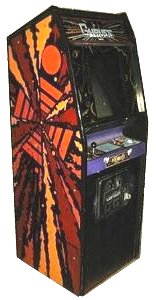 The Game: The aliens are taking their complaints to the home office! As the pilot of an agile space fighter, you have to blast your way through the alien forces from Pluto all the way back to Earth. Occasionally you can boost your ship’s firepower, but that’s the only help you’re going to get. The rest is up to your speed, your
The Game: The aliens are taking their complaints to the home office! As the pilot of an agile space fighter, you have to blast your way through the alien forces from Pluto all the way back to Earth. Occasionally you can boost your ship’s firepower, but that’s the only help you’re going to get. The rest is up to your speed, your  strategy, and your ability to nail the attackers in mid-dive. (Centuri [under license from Konami], 1983)
strategy, and your ability to nail the attackers in mid-dive. (Centuri [under license from Konami], 1983)
Memories: Konami’s cult classic basically put a vaguely Tempest-esque 3-D spin on the strategy of Galaga, borrowed some music from a certain Mr. Bach and blasted it out as a stereo techno-symphony, and got a lot of people to blow their hard-earned money. It was also a lot of fun.
Guzzler
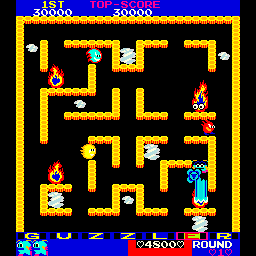 The Game: As a fluid little fellow, you zip around a maze flooded with flaming foes who’ll fry you with fire without fair warning. However, since water can put out fire, you can belch forth a mighty stream of water at your enemies, extinguishing them instantly. However, you’re only a little Guzzler, so you only contain a certain amount of water. You replenish yourself very slowly, but you can gobble up clouds full of moisture or drink from a fountain that occasionally appears at the center of the maze to refill yourself more quickly. And some fires are bigger than others, and putting them out will accordingly take more out of you. And you do eventually run out of clouds… (Tekhan, 1983)
The Game: As a fluid little fellow, you zip around a maze flooded with flaming foes who’ll fry you with fire without fair warning. However, since water can put out fire, you can belch forth a mighty stream of water at your enemies, extinguishing them instantly. However, you’re only a little Guzzler, so you only contain a certain amount of water. You replenish yourself very slowly, but you can gobble up clouds full of moisture or drink from a fountain that occasionally appears at the center of the maze to refill yourself more quickly. And some fires are bigger than others, and putting them out will accordingly take more out of you. And you do eventually run out of clouds… (Tekhan, 1983)
Memories: An incredibly fun, easy-to-learn, challenging, and cute game, Guzzler was always a favorite of mine, though I only got to play it in the arcade a handful of times. But this innovative take on the maze-chase theme that pervaded many an ’80s arcade game appears to have barely made a drop in the bucket of video game history.
Food Fight
 The Game: You are Charley – but you don’t have the Golden Ticket. Instead, what you have is a playfield littered with immobilizing potholes, lots of food, and four feisty chefs (is there a different word for the plural of “chef”?). Charley Chuck can pick up handfuls of food and fling them at any one of his opponents, but keep in mind that they can do the same. Charley’s ultimate goal? Reach the yummy ice cream cone at the opposite end of the screen without falling victim to any of the above. To do any less causes every piece of food on the screen to hurl itself at Charley. (Atari, 1983)
The Game: You are Charley – but you don’t have the Golden Ticket. Instead, what you have is a playfield littered with immobilizing potholes, lots of food, and four feisty chefs (is there a different word for the plural of “chef”?). Charley Chuck can pick up handfuls of food and fling them at any one of his opponents, but keep in mind that they can do the same. Charley’s ultimate goal? Reach the yummy ice cream cone at the opposite end of the screen without falling victim to any of the above. To do any less causes every piece of food on the screen to hurl itself at Charley. (Atari, 1983)
Memories: This bizarre little game is the first original arcade effort from a small game design firm called General Computer, which was actually responsible for Ms. Pac-Man, which started out as an unauthorized modification kit. Caught in the act, General Computer’s founders offered the game to Namco, and it went on to become the best-earning arcade game of its day. A similar “enhancement” devised for Atari’s Missile Command, however, got them in hot water.
The Empire Strikes Back

 The Game: You are Rebel snowspeeder pilot Luke Skywalker, flying low over the surface of Hoth, prowling for Probots and waging war on AT-ATs and AT-STs. (Atari, 1983)
The Game: You are Rebel snowspeeder pilot Luke Skywalker, flying low over the surface of Hoth, prowling for Probots and waging war on AT-ATs and AT-STs. (Atari, 1983)
Memories: The description sounds rather glib, but there’s a simple reason for it – this game, based on the 1980 sequel to Star Wars, is – in case you hadn’t guessed it from the screen shots – merely a very thinly-disguised makeover of Atari’s original Star Wars arcade game. Ripped straight out of the second level of Star Wars, The Empire Strikes Back replaces the towers and bunkers with probe droids and Imperial Walkers, replaces the X-Wing gunsights of the earlier game with two Snowspeeder blasters, and voilà , it’s a new game – almost.
Elevator Action
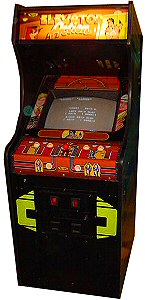 The Game: Love in an elevator, it’s not. As a daring spy, you break into a top secret enemy facility, trying to grab vital secrets and evade or kill as many enemy agents as you can. Your only means of getting from floor to floor through most of the game is via the elevator – which gives you an advantage and also makes you vulnerable. (Taito, 1983)
The Game: Love in an elevator, it’s not. As a daring spy, you break into a top secret enemy facility, trying to grab vital secrets and evade or kill as many enemy agents as you can. Your only means of getting from floor to floor through most of the game is via the elevator – which gives you an advantage and also makes you vulnerable. (Taito, 1983)
 Memories: This neat little entry from Taito wound up eating a lot of my allowance money back when I was eleven years old. There was a genuine sense of trying to reach a goal (though, to this day, even with emulation and official retro collections, I have no idea what lies below, say, the 20th level of the enemy compound). Elevator Action is also a real test of one’s mental multitasking abilities: agents closing in on all sides, elevator going down…do you jump? Duck? Shoot the agents? Shoot out the overhead lights? Some combination of the above? Whew.
Memories: This neat little entry from Taito wound up eating a lot of my allowance money back when I was eleven years old. There was a genuine sense of trying to reach a goal (though, to this day, even with emulation and official retro collections, I have no idea what lies below, say, the 20th level of the enemy compound). Elevator Action is also a real test of one’s mental multitasking abilities: agents closing in on all sides, elevator going down…do you jump? Duck? Shoot the agents? Shoot out the overhead lights? Some combination of the above? Whew.
Dragon’s Lair
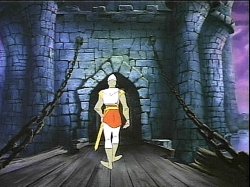 The Game: As valiant but clumsy knight Dirk the Daring, you’re on a hazardous quest to rescue Princess Daphne from a huge, hungry dragon. There are all kinds of dangers on the way, including Giddy Goons, the Black Knight, the
The Game: As valiant but clumsy knight Dirk the Daring, you’re on a hazardous quest to rescue Princess Daphne from a huge, hungry dragon. There are all kinds of dangers on the way, including Giddy Goons, the Black Knight, the  Smithee, the Lizard King, and all kinds of other evil critters and contraptions. (Starcom, 1983)
Smithee, the Lizard King, and all kinds of other evil critters and contraptions. (Starcom, 1983)
Memories: Dragon’s Lair was the first laserdisc game to hit the arcades, an early field that included Starcom’s Space Ace and other manufacturers’ Cliff Hanger, among only a handful of others. The Sega laser game Astron Belt was actually in development earlier than Dragon’s Lair, but it languished in the video game equivalent of Hollywood’s “development hell,” meaning that it didn’t arrive until it was an also-ran.
Donkey Kong 3
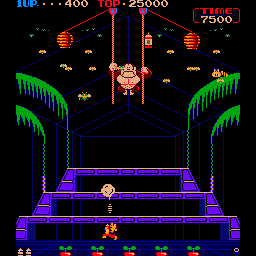 The Game: As Stanley the gardener, you’re trying to repel a swarm of pests unleashed by that meanest of pixellated gorillas, while also using your pesticide to propel him off the screen. Protect your flowers and yourself, and wear plenty of Off. (Nintendo, 1983)
The Game: As Stanley the gardener, you’re trying to repel a swarm of pests unleashed by that meanest of pixellated gorillas, while also using your pesticide to propel him off the screen. Protect your flowers and yourself, and wear plenty of Off. (Nintendo, 1983)
Memories: The third entry in the still-ongoing series of games spawned by the original Donkey Kong, Donkey Kong 3 wasn’t as successful as the previous sequel, Donkey Kong Junior. One possible reason for this could be Nintendo’s brief abandonment of the climbing/jumping game elements in favor of a shooting game whose roots could easily be traced back to Space Invaders.
Dogfight
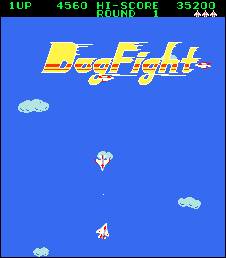 The Game: Enemy fighters arrive, wave after wave, attempting to outflank the player’s fighter jet and trap it in the path of their fire. The player can only move the jet side to side to avoid incoming fire and attempt to line up a shot on the enemy fighters. Each new wave of enemies brings new tactics, new weapons to evade… and a new batch of targets. (Thunderbolt [under license to Orca], 1983)
The Game: Enemy fighters arrive, wave after wave, attempting to outflank the player’s fighter jet and trap it in the path of their fire. The player can only move the jet side to side to avoid incoming fire and attempt to line up a shot on the enemy fighters. Each new wave of enemies brings new tactics, new weapons to evade… and a new batch of targets. (Thunderbolt [under license to Orca], 1983)
Memories: It’s easy to imagine the design and planning meeting for this game. It goes something like this:
“You know what my favorite part of Galaga is? The challenging stage. I hate all those other stages. They’re just there to trip me up on my way to the challenging stage. What if we made a game where the whole thing is like the challenging stage, except they occasionally shoot back at you?”
Discs Of Tron
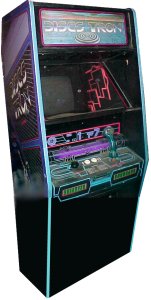
 The Game: It’s the final confrontation between good and evil in the digital world! As video warrior Tron, you unleash up to three deadly discs in the direction of your arch-enemy Sark, who can return the favor in kind – with interest, since he has a larger arsenal at his disposal. All the while, you must also avoid falling off of the floating platforms, and try to keep a good aim on your opponent. (Bally/Midway, 1983)
The Game: It’s the final confrontation between good and evil in the digital world! As video warrior Tron, you unleash up to three deadly discs in the direction of your arch-enemy Sark, who can return the favor in kind – with interest, since he has a larger arsenal at his disposal. All the while, you must also avoid falling off of the floating platforms, and try to keep a good aim on your opponent. (Bally/Midway, 1983)
Memories: Midway’s second salute to Tron, that 1982 cult-classic film favorite among computer users and video game enthusiasts alike, took the form of a positively enormous “stand-in” wraparound cabinet with a large screen. (Not seen in the ubiquitous MAME-generated series of screen shots is the colorful background artwork, which was a scene from the movie.)
Crystal Castles
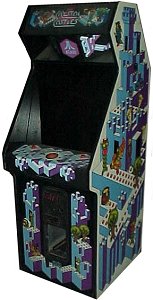
 The Game: You are Bentley the Bear, cuddly defender of a vaguely 3-D fairy tale realm just loaded with ruby-like crystals. While this would seem like an idyllic existence for many sentient stuffed animals, it is, of course, not that easy. Berthilda the Witch has sent her evil minions to seize the crystals for her. Walking trees, upright centipedes, and animated skeletons prowl the geometric vistas to keep Bentley from claiming the crystals. Finding the wizard hat will briefly give Bentley the power to dispose of Berthilda if and when she makes an appearance. Bentley also has a weakness for the pot of honey that appears on each level – and if he grabs the honey, a swarm of bees suddenly has a problem with him. Clearing each screen of crystals advances to the next level. Keep in mind that the enemies can also consume crystals, so they may actually clear the level – Bentley gets a bonus if he’s the one who nabs the last gem on the screen. (Atari, 1983)
The Game: You are Bentley the Bear, cuddly defender of a vaguely 3-D fairy tale realm just loaded with ruby-like crystals. While this would seem like an idyllic existence for many sentient stuffed animals, it is, of course, not that easy. Berthilda the Witch has sent her evil minions to seize the crystals for her. Walking trees, upright centipedes, and animated skeletons prowl the geometric vistas to keep Bentley from claiming the crystals. Finding the wizard hat will briefly give Bentley the power to dispose of Berthilda if and when she makes an appearance. Bentley also has a weakness for the pot of honey that appears on each level – and if he grabs the honey, a swarm of bees suddenly has a problem with him. Clearing each screen of crystals advances to the next level. Keep in mind that the enemies can also consume crystals, so they may actually clear the level – Bentley gets a bonus if he’s the one who nabs the last gem on the screen. (Atari, 1983)
Memories: A bizarre little game with play elements of Pac-Man set in an almost Q*Bert-like perspective, Crystal Castles was actually quite the quantum leap forward for graphics back in ’83. (It would later be blown out of the water by Atari’s own Marble Madness not long afterward.) It was also one of the earliest games to utilize Atari’s System 1 hardware.
Crossbow
 The Game: Your friends (wait a minute, I’ve never seen these people before in my life!) are venturing through treacherous deserts, unfriendly villages, and a variety of other inhospitable settings. Armed with a crossbow – controlled with a fancy light gun mounted on the arcade cabinet – your job is to pick off any threats, be they nasty critters, falling projectiles, snipers, or what have you, and allow your friends to pass safely. (Exidy, 1983)
The Game: Your friends (wait a minute, I’ve never seen these people before in my life!) are venturing through treacherous deserts, unfriendly villages, and a variety of other inhospitable settings. Armed with a crossbow – controlled with a fancy light gun mounted on the arcade cabinet – your job is to pick off any threats, be they nasty critters, falling projectiles, snipers, or what have you, and allow your friends to pass safely. (Exidy, 1983)
Memories: Y’know, I had to play Crossbow on MAME to remember what the heck the game was about…but once I did, I remembered that it was a very influential game on me at the time it was released. The novel concept of picking which game screen you’d explore next by shooting a representative icon on a menu-style screen was very cool, as was the watered-down, vaguely-D&D-ish atmosphere of the whole thing.
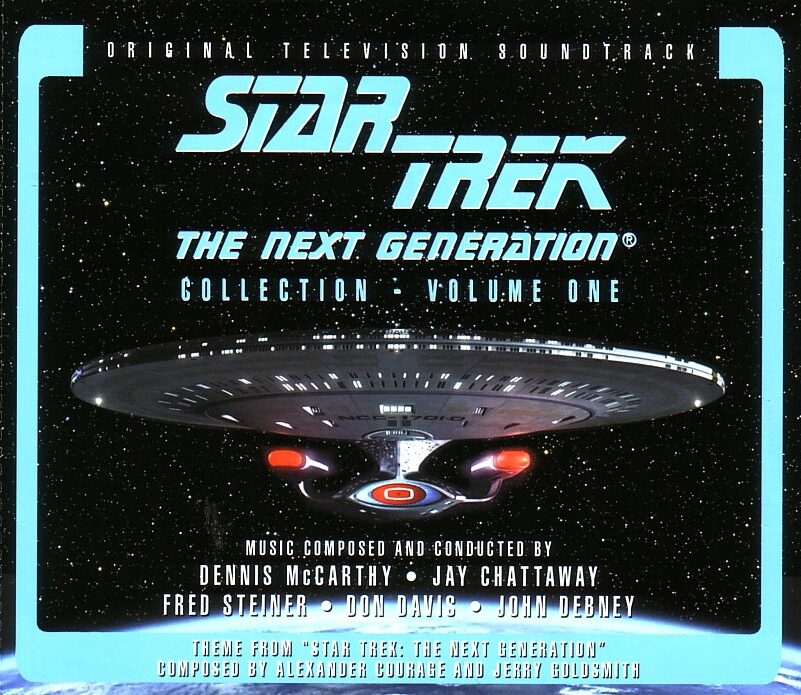
Congo Bongo
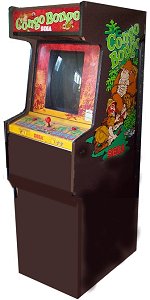 The Game: Bongo the Ape, presumably Donkey Kong’s third cousin, sets your toes on fire while you’re asleep during a jungle expedition. So naturally, you drop everything to take revenge on the goofy gorilla. But first you have to reach him. The first level is a hazardous assortment of ramps and levels and a waterfall to jump across. Be careful of pesky little monkeys who can weigh you down so you move slower (and jump lower). And watch out for snakes. Then you have to hop across various islands and dodge more snakes as you try to get across a river. The most difficult level is the third, where you must try to dodge charging rhinos (and I don’t mean they have credit cards), occasionally ducking out of sight in little sinkholes where you get to squash other critters. The fourth level is very Frogger-like, consisting of riding across another river on the backs of hippos, fish, and lily pads. When you complete this screen, you set Bongo’s toes on fire as he sleeps…and then the whole thing starts again. (Sega, 1983)
The Game: Bongo the Ape, presumably Donkey Kong’s third cousin, sets your toes on fire while you’re asleep during a jungle expedition. So naturally, you drop everything to take revenge on the goofy gorilla. But first you have to reach him. The first level is a hazardous assortment of ramps and levels and a waterfall to jump across. Be careful of pesky little monkeys who can weigh you down so you move slower (and jump lower). And watch out for snakes. Then you have to hop across various islands and dodge more snakes as you try to get across a river. The most difficult level is the third, where you must try to dodge charging rhinos (and I don’t mean they have credit cards), occasionally ducking out of sight in little sinkholes where you get to squash other critters. The fourth level is very Frogger-like, consisting of riding across another river on the backs of hippos, fish, and lily pads. When you complete this screen, you set Bongo’s toes on fire as he sleeps…and then the whole thing starts again. (Sega, 1983)
Memories: Congo Bongo was entertaining enough, though it suffered from some of the same frustrations caused by the overhead 3-D graphic scheme that originated with Sega’s own Zaxxon. In some ways, Congo Bongo was nothing more than a 3-D version of Donkey Kong, right down to the pesky primate.
Cliff Hanger
 The Game: You’re Cliff, a lovable rogue who’s just pulled off a major heist. But as you’re high-tailing it for your hideout via your getaway car, you encounter another crime even more heinous – a carload of armed thugs pursuing a young woman. You have to rescue her as soon as possible – and since she already has mobsters and other villains after her, the danger just piles on from there. (Stern, 1983)
The Game: You’re Cliff, a lovable rogue who’s just pulled off a major heist. But as you’re high-tailing it for your hideout via your getaway car, you encounter another crime even more heinous – a carload of armed thugs pursuing a young woman. You have to rescue her as soon as possible – and since she already has mobsters and other villains after her, the danger just piles on from there. (Stern, 1983)
Memories: Another exponent of the laserdisc genre that begat Dragon’s Lair and Space Ace, Cliff Hanger was Stern’s entry into the then-crowded field. But rather than create new animation from the ground up – a costly endeavour for those aforementioned games created by Don Bluth – Stern simply licensed footage from a couple of classic animè movies from the Lupin III series, drawing primarily from The Castle Of Cagliostro (whose DVD these screen captures are from).
Bubbles

 The Game: This is an interactive documentary about the life of a Scrubbing Bubble. As a small bubble, your job is to scoot around the sink, soaking up smaller bubbles, bits of dirt, and any ants that wander into your path. As you accrete more common kitchen debris, your bubble grows bigger and begins to form a face. When your bubble is big enough to sport a big ant-eating grin, you can start to do real damage. Razor blades are always deadly; roving brushes are deadly until your bubble has a mouth, and roaches are deadly unless you can dispatch them with a broom that periodically appears. When the drain at the center of the sink flashes green, you can slide down the drain and advance a level – something which you can only otherwise accomplish by clearing the sink of “edible” items. (Williams Electronics, 1983)
The Game: This is an interactive documentary about the life of a Scrubbing Bubble. As a small bubble, your job is to scoot around the sink, soaking up smaller bubbles, bits of dirt, and any ants that wander into your path. As you accrete more common kitchen debris, your bubble grows bigger and begins to form a face. When your bubble is big enough to sport a big ant-eating grin, you can start to do real damage. Razor blades are always deadly; roving brushes are deadly until your bubble has a mouth, and roaches are deadly unless you can dispatch them with a broom that periodically appears. When the drain at the center of the sink flashes green, you can slide down the drain and advance a level – something which you can only otherwise accomplish by clearing the sink of “edible” items. (Williams Electronics, 1983)
Memories: Okay, and the designers at Williams were smoking what, exactly, when they dreamed this one up?
But I kid Bubbles. It’s actually a pretty cool game, and a rare example of a cutesy game from Williams, a company which usually turned out such macho, kill-’em-all shooters as Defender, Sinistar and Robotron. Williams’ only other entry in the cute game genre was Make Trax (which almost doesn’t count, since it was licensed from an obscure Japanese manufacturer).
Botanic
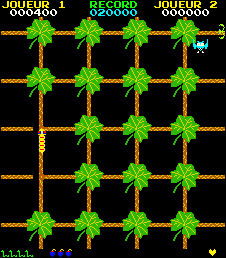 The Game: Players control a caterpillar, hungrily navigating a twisty maze of twigs and branches to eat leaves. Sometimes the player’s caterpillar will have reached a dead end, but this is not revealed until the leaf covering that dead end is consumed. Other insects swarm around the caterpillar, trying to catch and eat it for themselves. At the beginning of each “life” the player can press a button, giving the caterpillar a brief bug-zerker rage, allowing it to eat its enemies for a change, but this change is short-lived; special flowers must be consumed to regain the ability. Once all of the leaves have been eaten in an entire maze (which takes up more than a single interlinked screen), a “home” appears, into which the caterpillar must be successfully guided for transformation into a butterfly. Then the player is given a new caterpillar to guide and a new maze to navigate. (Valadon Automation [under license to Iti S.A.], 1983)
The Game: Players control a caterpillar, hungrily navigating a twisty maze of twigs and branches to eat leaves. Sometimes the player’s caterpillar will have reached a dead end, but this is not revealed until the leaf covering that dead end is consumed. Other insects swarm around the caterpillar, trying to catch and eat it for themselves. At the beginning of each “life” the player can press a button, giving the caterpillar a brief bug-zerker rage, allowing it to eat its enemies for a change, but this change is short-lived; special flowers must be consumed to regain the ability. Once all of the leaves have been eaten in an entire maze (which takes up more than a single interlinked screen), a “home” appears, into which the caterpillar must be successfully guided for transformation into a butterfly. Then the player is given a new caterpillar to guide and a new maze to navigate. (Valadon Automation [under license to Iti S.A.], 1983)
Memories: If you remember playing Botanic in your local arcade, your local arcade must have been in France or Spain, since Botanic did not receive worldwide distribution. Valadon Automation, the originators of Bagman (a game which did receive worldwide distribution), licensed Botanic from Palamos, Spain-based game maker Iti S.A.
Blaster
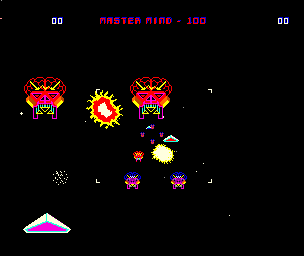
 The Game: The human race narrowly escapes the conquering of Earth by the merciless Robotrons. The last surviving remnants of mankind scatter as they leave the planet, heading for a distant world known as Paradise. Your job? Make sure they get there – by blasting away at anything and everything along the perilous journey. (Williams Electronics, 1983)
The Game: The human race narrowly escapes the conquering of Earth by the merciless Robotrons. The last surviving remnants of mankind scatter as they leave the planet, heading for a distant world known as Paradise. Your job? Make sure they get there – by blasting away at anything and everything along the perilous journey. (Williams Electronics, 1983)
Memories: In the continuation of the Defender / Stargate / Robotron story cycle, Blaster builds nicely on the nearly-movie-worthy saga by picking up from the inevitable conclusion of Robotron (i.e., the protagonist’s death). Now humanity is on the run, and there are all kinds of nasty creatures waiting to finish the human race off, including the Masterminds, which look a lot like Robotron‘s Brains, only more hideous (imagine a large brain wearing a Darth Vader faceplate, and you’ll get the idea.)
Astron Belt
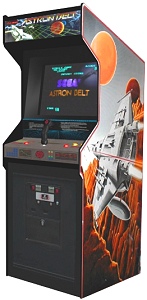 The Game: You’re a lone space pilot on patrol in the middle of an intergalactic war. In deep space, on craggy hazardous planet surfaces and at all points in between, you’re a target for enemy forces, and while you can defend yourself, danger comes from all sides without warning: enemy fire, collisions with the landscape or enemy ships, and that old standby, pilot error. The video footage in the background comes from Toei Studios’ 1979 opus Message From Earth and, somewhat surprisingly, Star Trek II. (Sega / Bally/Midway, 1983)
The Game: You’re a lone space pilot on patrol in the middle of an intergalactic war. In deep space, on craggy hazardous planet surfaces and at all points in between, you’re a target for enemy forces, and while you can defend yourself, danger comes from all sides without warning: enemy fire, collisions with the landscape or enemy ships, and that old standby, pilot error. The video footage in the background comes from Toei Studios’ 1979 opus Message From Earth and, somewhat surprisingly, Star Trek II. (Sega / Bally/Midway, 1983)
Memories: In 1983, several companies seemed to simultaneously roll out arcade games based on the engineering principle that some or all of the game’s graphics would be played by a videodisc player. In the age of videotape, videodisc technology wasn’t perfect, but it presented something that was absolutely vital for bringing pre-recorded video to a game environment: random access. Without that, any game using pre-recorded video would’ve been forced to show the same sequence of visuals no matter what the player did.
Arabian
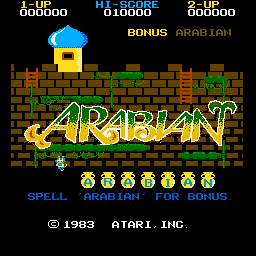 The Game: Bring your turban up to speed! As you’re serenaded with a monophonic rendition of Rimsky Korsakov’s “Scheherazade”, you climb and jump and kick your way to collecting all the letters on the screen. If you collect them in the correct order to spell ARABIAN, you get a bonus before moving on to the next screen. And watch out for the big genie… (Atari, 1983)
The Game: Bring your turban up to speed! As you’re serenaded with a monophonic rendition of Rimsky Korsakov’s “Scheherazade”, you climb and jump and kick your way to collecting all the letters on the screen. If you collect them in the correct order to spell ARABIAN, you get a bonus before moving on to the next screen. And watch out for the big genie… (Atari, 1983)
Memories: This is a rather cute and simplistic game, but it’s not a pushover. I can’t tell you how many quarters Arabian relieved me of. And even while playing it in MAME to grab screen stills for this page, it kicked my scrawny little pixellated butt.